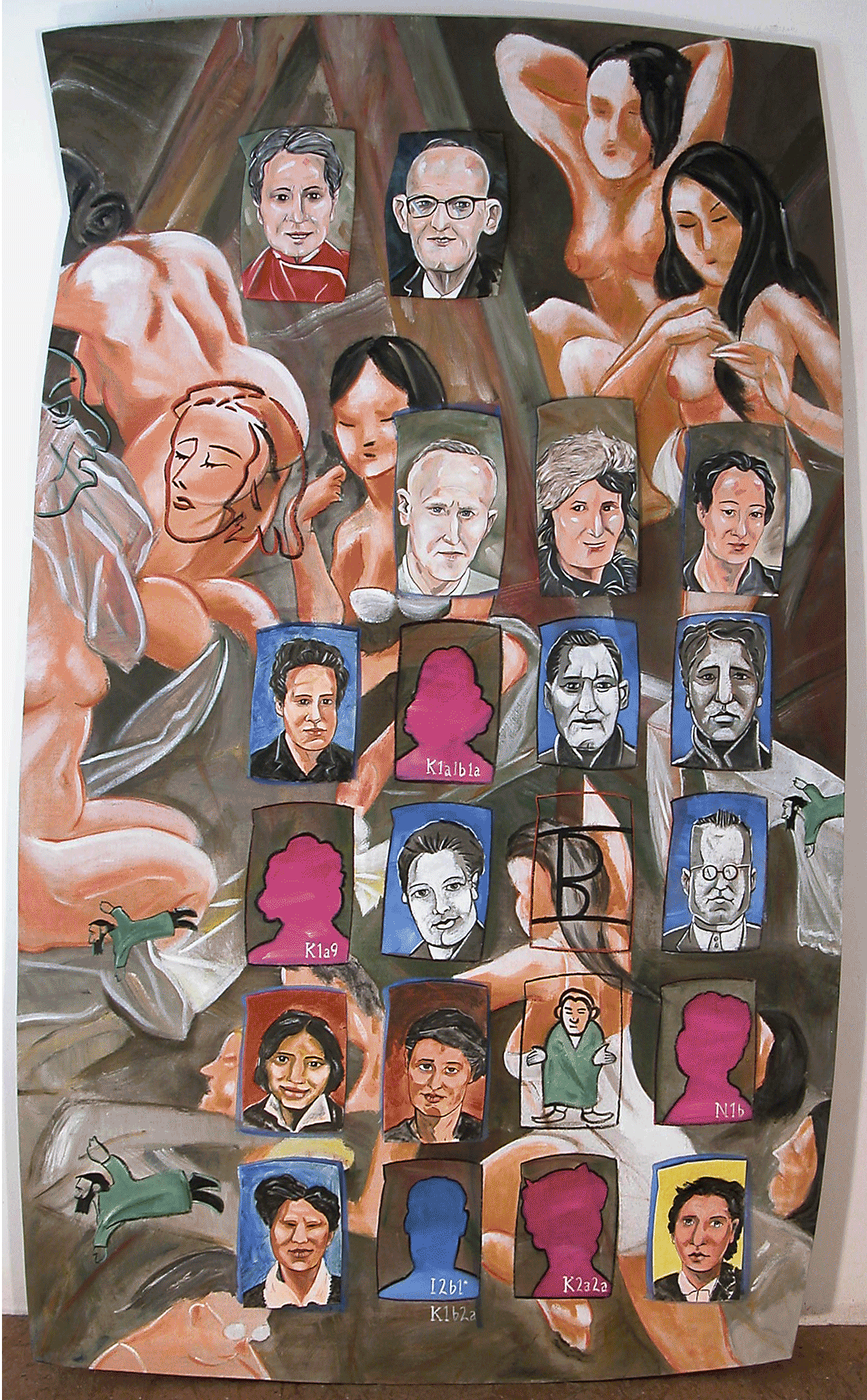"Boelongan" is a fusion project, encompassing paintings, drawings, films of shadowplayfigures and a music suite of eight new compositions. The philosophical frame headed first for social networks like facebook, myspace and similar databanks, trying to install vertical connections with a historical depth instead of the usual horizontal ones like in the web. A preliminary work in this field has been the painting "Rassenschande"
Zänder: “Rassenschande”
( 2010, Acryl & Öl auf Lwd ),
( 2010, Acryl & Öl auf Lwd ),
connecting inhabitants of the women concentration camp in Ravensbrück, both aggressors with their victims in an applicational way, only nowadays web circles can do.
The touching fate of a real couple (Dr. Kurt Wohl and his later wife Klara Zänder), occuring in my own family should serve as an anchor for a very complex project, opening up the opportunity for the first painting of a genetic landscape on earth with all its diversity, positioned in a framework of some hundred reference populations. First steps had been made and I planned to look for genetic traces of my grandaunt and her husband, as they can be found on the backside of usual stamps.
That was the main reason to head for the Gestapo data of my granduncle Dr. Kurt Wohl and in his letters from Soerabaya, Java to my aunt from 1939 ( both stored in the Landesarchiv Düsseldorf ) as well as from the correspondence of Walter Spies, who died on the same day and boat Van Imhoff early in 1942 as the son of Kurt Wohl, Werner Wohl. The Walter Spies Archiv is accessible to me in the Rautenstrauch Joest Museum of Cologne, where I give Gamelan courses for schoolclasses and other people, interested in Gamelan. Walter Spies role in bringing indonesian culture to Europe cannot be judged high enough.
He introduced Colin McPhee into balinese culture, transposing the classical gender wayang repertoire to piano duos. I saw in the archive a complete file folder containing the correspondence with Jaap Kunst, who was the first ethnomusicologist to demand to study the music from inside by practising instead of judging from outside. I played on his simple instruments in Amsterdam. His main pupil was Kyai Mantle Hood, who brought the first gamelan to the US in 1954. I had the personal pleasure to have him as guest in Cologne and to pass some week in his house in Bali. His friend Ni Nyoman Candri was so kind to give me the words for my piece "saling asuh".
In 1939 Dr. Kurt Wohl emigrated to Java, where his son Werner lived in Soerabaya as an employee for a German company, situated in Remscheid. As a Jewish adoptee he had to leave Germany, after the Nazis had declined the permission to conduct a medical praxis in Wermelskirchen and confisqued all his properties. In Java he was awaiting my grandaunt Kläre Zänder. They wanted to get married and she had already arranged a new employment in Java. During the course of the year 1939 Kurt Wohl wrote about 30 letters to Kläre, which are still available in the Gestapo files in the Landesarchiv Düsseldorf as well as the official protocols. I made excerpts for new songtexts using parts of these files. They will be published separately. Shortly before her departure my aunt was denunciated by neighbours in her hometown Liegnitz, arrested and accused for illegal money transfer and violation against race laws ( Rassenschande ). She passed three and a half years in the women concentration camp of Ravensbrück. After the German invasion of the Netherlands in 1940 all Germans in Indonesia got arrested in revenge, so Kurt Wohl and his son and independently Walter Spies. About 2600 German male prisoners were collected in a camp in Sumatra and there divided into two groups, one encompassing about 2000 regime friendly Germans, the other gathering the wild rest in the "traitors block C".
The first were safely transported on two ships, the Ophir and the Plancius to Ceylon late in 1941, the others, almost 600 Germans, had to wait, until they got emprisoned on the dutch freighter “Van Imhoff”, who wasn’t declared as a transporter for prisoners and thus bombed by a japanese aeroplane the 19.1.1942. By chance Dr. Kurt Wohl did not leave Sibolga, because the Dutch governement had found a better use for a German doctor. Otherwise he would have shared the fate of his son Werner and that of Walter Spies and Hans Overbeck, who all drowned with the “van Imhoff”.
The day after the bombing less than 100 survivors were floating on the last rescue boat on the sea, heading Sumatra, when they encountered another dutch freighter, named “Boelongan”, who left the area immediatedly after hearing, that only Germans were there. There seems to have been the order, not to rescue any Germans ( https://www.youtube.com/watch?v=MtcYeF_-yDA ).
The Boelongan was drowned some weeks later. There are diving tours to its shipwreck now. ( https://www.youtube.com/watch?v=MLjp1O6DAj4 )
Late in the forties the couple met again in Java, married and lived in Bandung until 1957, when they decided to pass his last years in Wermelskirchen, where he died in 1961.
As a child I passed a lot of weekends in their house, probably a deep reason for my faible for indonesian culture. For more than 16 years now I’m playing javanese and balinese Gamelan music, mixing it now with Jazz elements.


